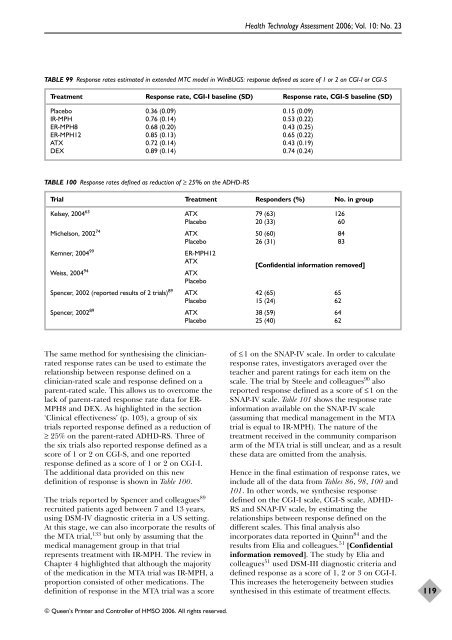A systematic review and economic model of the effectiveness and ...
A systematic review and economic model of the effectiveness and ...
A systematic review and economic model of the effectiveness and ...
You also want an ePaper? Increase the reach of your titles
YUMPU automatically turns print PDFs into web optimized ePapers that Google loves.
The same method for syn<strong>the</strong>sising <strong>the</strong> clinicianrated<br />
response rates can be used to estimate <strong>the</strong><br />
relationship between response defined on a<br />
clinician-rated scale <strong>and</strong> response defined on a<br />
parent-rated scale. This allows us to overcome <strong>the</strong><br />
lack <strong>of</strong> parent-rated response rate data for ER-<br />
MPH8 <strong>and</strong> DEX. As highlighted in <strong>the</strong> section<br />
‘Clinical <strong>effectiveness</strong>’ (p. 103), a group <strong>of</strong> six<br />
trials reported response defined as a reduction <strong>of</strong><br />
≥ 25% on <strong>the</strong> parent-rated ADHD-RS. Three <strong>of</strong><br />
<strong>the</strong> six trials also reported response defined as a<br />
score <strong>of</strong> 1 or 2 on CGI-S, <strong>and</strong> one reported<br />
response defined as a score <strong>of</strong> 1 or 2 on CGI-I.<br />
The additional data provided on this new<br />
definition <strong>of</strong> response is shown in Table 100.<br />
The trials reported by Spencer <strong>and</strong> colleagues 89<br />
recruited patients aged between 7 <strong>and</strong> 13 years,<br />
using DSM-IV diagnostic criteria in a US setting.<br />
At this stage, we can also incorporate <strong>the</strong> results <strong>of</strong><br />
<strong>the</strong> MTA trial, 133 but only by assuming that <strong>the</strong><br />
medical management group in that trial<br />
represents treatment with IR-MPH. The <strong>review</strong> in<br />
Chapter 4 highlighted that although <strong>the</strong> majority<br />
<strong>of</strong> <strong>the</strong> medication in <strong>the</strong> MTA trial was IR-MPH, a<br />
proportion consisted <strong>of</strong> o<strong>the</strong>r medications. The<br />
definition <strong>of</strong> response in <strong>the</strong> MTA trial was a score<br />
© Queen’s Printer <strong>and</strong> Controller <strong>of</strong> HMSO 2006. All rights reserved.<br />
Health Technology Assessment 2006; Vol. 10: No. 23<br />
TABLE 99 Response rates estimated in extended MTC <strong>model</strong> in WinBUGS: response defined as score <strong>of</strong> 1 or 2 on CGI-I or CGI-S<br />
Treatment Response rate, CGI-I baseline (SD) Response rate, CGI-S baseline (SD)<br />
Placebo 0.36 (0.09) 0.15 (0.09)<br />
IR-MPH 0.76 (0.14) 0.53 (0.22)<br />
ER-MPH8 0.68 (0.20) 0.43 (0.25)<br />
ER-MPH12 0.85 (0.13) 0.65 (0.22)<br />
ATX 0.72 (0.14) 0.43 (0.19)<br />
DEX 0.89 (0.14) 0.74 (0.24)<br />
TABLE 100 Response rates defined as reduction <strong>of</strong> ≥ 25% on <strong>the</strong> ADHD-RS<br />
Trial Treatment Responders (%) No. in group<br />
Kelsey, 200463 ATX 79 (63) 126<br />
Placebo 20 (33) 60<br />
Michelson, 2002 74 ATX 50 (60) 84<br />
Placebo 26 (31) 83<br />
Kemner, 2004 99 ER-MPH12<br />
ATX<br />
[Confidential information removed]<br />
Weiss, 2004 94 ATX<br />
Placebo<br />
Spencer, 2002 (reported results <strong>of</strong> 2 trials) 89 ATX 42 (65) 65<br />
Placebo 15 (24) 62<br />
Spencer, 2002 89 ATX 38 (59) 64<br />
Placebo 25 (40) 62<br />
<strong>of</strong> ≤1 on <strong>the</strong> SNAP-IV scale. In order to calculate<br />
response rates, investigators averaged over <strong>the</strong><br />
teacher <strong>and</strong> parent ratings for each item on <strong>the</strong><br />
scale. The trial by Steele <strong>and</strong> colleagues 90 also<br />
reported response defined as a score <strong>of</strong> ≤1 on <strong>the</strong><br />
SNAP-IV scale. Table 101 shows <strong>the</strong> response rate<br />
information available on <strong>the</strong> SNAP-IV scale<br />
(assuming that medical management in <strong>the</strong> MTA<br />
trial is equal to IR-MPH). The nature <strong>of</strong> <strong>the</strong><br />
treatment received in <strong>the</strong> community comparison<br />
arm <strong>of</strong> <strong>the</strong> MTA trial is still unclear, <strong>and</strong> as a result<br />
<strong>the</strong>se data are omitted from <strong>the</strong> analysis.<br />
Hence in <strong>the</strong> final estimation <strong>of</strong> response rates, we<br />
include all <strong>of</strong> <strong>the</strong> data from Tables 86, 98, 100 <strong>and</strong><br />
101. In o<strong>the</strong>r words, we syn<strong>the</strong>sise response<br />
defined on <strong>the</strong> CGI-I scale, CGI-S scale, ADHD-<br />
RS <strong>and</strong> SNAP-IV scale, by estimating <strong>the</strong><br />
relationships between response defined on <strong>the</strong><br />
different scales. This final analysis also<br />
incorporates data reported in Quinn 84 <strong>and</strong> <strong>the</strong><br />
results from Elia <strong>and</strong> colleagues. 51 [Confidential<br />
information removed]. The study by Elia <strong>and</strong><br />
colleagues 51 used DSM-III diagnostic criteria <strong>and</strong><br />
defined response as a score <strong>of</strong> 1, 2 or 3 on CGI-I.<br />
This increases <strong>the</strong> heterogeneity between studies<br />
syn<strong>the</strong>sised in this estimate <strong>of</strong> treatment effects.<br />
119
















